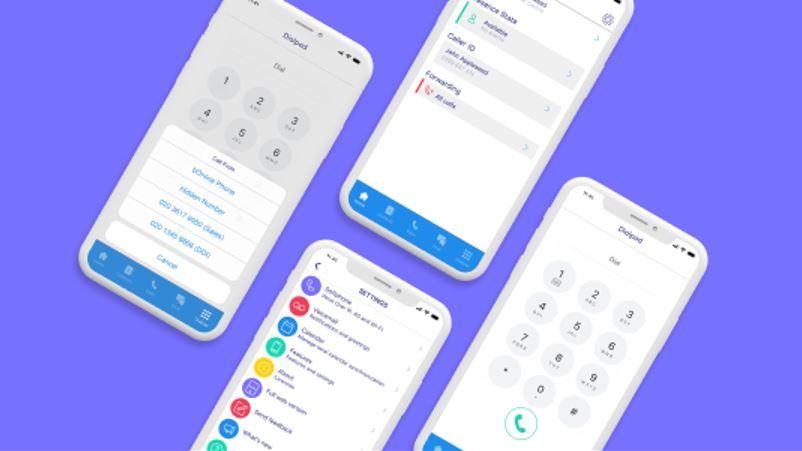Table of Contents
What is VoIP? A guide for businesses 2021
Did you know that “businesses that switch to VoIP reduce the cost of their local calls by up to 40%, and save up to 90% on international calls”? This is what makes VoIP worth learning about and investing in as business.
Businesses that switch to VoIP reduce the cost of their local calls by up to 40%, and save up to 90% on international calls
Spending time understanding what VoIP is and how VoIP works can help you save a lot as a business long-term. Understanding this modern digitally-based business phone system is key to choosing the best VoIP services later on.
You’ve also likely run into the acronym SIP, or Session Initiation Protocol in connection with VoIP. In fact, navigating the world of business phone systems can often feel like an alphabet soup of acronyms. In this article we’ll only be looking at what VoIP is in detail, and how it works with SIP. However, you can learn more about SIP and its difference from VoIP in our article, SIP vs. VoIP: a guide for businesses.
What is VoIP?
First things first, what is VoIP and what exactly does it stand for? VoIP stands for Voice over Internet Protocol and is essentially a digital phone service. Instead of sending audio through traditional phone lines, VoIP phone systems digitize your voice and send packets of audio over the internet.
In some ways, VoIP is a lot like making a video call—except that you’re only sending audio, not video, back and forth.
As a cost-effective alternative to the traditional analog phone system, businesses enjoy significant savings with cloud based telephony systems like VoIP. With free quotes from the best VoIP phone providers, your business can too.

We’ve listed the best VoIP services and best VoIP headsets available for businesses to help give you a head start in your search. Why not also take a look at our popular Nextiva VoIP services review?
Thanks to a rise in remote working and customer preference to contact businesses by phone, popularity for VoIP phone software and VoIP hardware is set to keep growing.
With VoIP phone systems, you can add as many phone lines as your business needs without having to bring in an electrician.
You can also integrate with software to automatically route your calls between departments or to keep a digital recording of every call that comes into your business.
What is SIP?
What is SIP? Well, not quite the refreshing summer drink you were imagining: SIP stands for Session Initiation Protocol. It’s an open-source communications protocol that is deployed by VoIP phone systems to function.
For VoIP business phone users, SIP is critical to initiating, maintaining, and terminating a phone call between two or more devices.
It’s particularly important to understand the word protocol in order to understand SIP. In this context, a protocol is a set of rules used by digital devices to communicate with each other.
VoIP is a communications system, and SIP is a signalling protocol used to support that communications system.
A protocol like SIP regulates how the exchange of data packets is synchronized between devices and how those data packets are interpreted.
The usefulness of Session Initiation Protocol isn’t limited to enabling VoIP business phone calls. SIP software can also be used to conduct video conferences, exchange instant messages, or distribute multimedia files and other data across global teams.
SIP vs VoIP: What’s the difference?
Trying to compare SIP and VoIP directly doesn’t really make sense. Why? Comparing the two is like assessing a magician and their assistant side by side.
One, VoIP, is the principal performer while the other is a support act. VoIP is a communications system, and SIP is a signalling protocol used to support that communications system.
SIP is one way to deploy your VoIP phone system. It’s favoured by telephony managers as it directly connects PBX (private branch exchange) users with public network phone users.
VoIP business phone systems which use SIP rely on the protocol, to relay information between VoIP-enabled devices. You may notice SIP and VoIP have become somewhat synonymous, since SIP is easily the most widely used protocol for supporting VoIP communications.
SIP trunking explained
With a single SIP trunk, you can have as many incoming or outgoing phone calls as your business requires.
To run a VoIP phone system using SIP, you’ll need a SIP trunk. If you’re wondering ‘what is a SIP trunk and how does it work?’, panic not. A SIP trunk can be defined as the piece of hardware that enables all the SIP-enabled phones and devices in your business to connect to the internet.
If you’re opting for a hosted VoIP service, your SIP trunk will likely located at a nearby data center.
Or, if you are self-hosting your own VoIP business phone system, the SIP trunk may be installed as part of your business’s internal telephony network.
The great thing about using SIP trunks is that they enable you to connect an unlimited number of lines. Practically, that means with a single SIP trunk, you can have as many incoming or outgoing phone calls as your business requires.
The most significant limitation on the number of simultaneous VoIP calls your company can handle boils down to your internet bandwidth.
Choosing the right hardware for SIP and VoIP
To run a successful VoIP business phone system based on SIP, you need to have compatible SIP hardware. What does compatible SIP hardware include?
Individual desk phones, which must be SIP-compatible. Analog phones, for example, won’t be able to connect to a SIP trunk to make and receive calls. The same is true for office phones designed for a protocol other than SIP.
The good news is that since SIP is so widely used for VoIP phone systems, the majority of business handsets and other VoIP-enabled devices are compatible with SIP.
So, you don’t have to spend a fortune to upgrade your business’s phones to a hard-to-get model. Always check to be certain.
The advantages of SIP for business
Why do so many VoIP providers and businesses use SIP as the protocol supporting their phone system? This protocol has become the most popular VoIP protocol because it offers a number of advantages over alternatives, including these:
✓ SIP is a highly flexible, integration-friendly protocol software
Data packets sent using SIP can be interpreted by other communication protocols, which opens the door for integration with non-SIP software.
This allows VoIP calls running on SIP to be automatically recorded using third-party software, for example, or for businesses to integrate their digital phone calls with a proprietary internal app.
SIP’s flexibility also means that your business is unlikely to run into compatibility problems if you change software platforms in the future.
✓ Quality-first, SIP processes VoIP call data individual devices
…is another reason why SIP is ideal for businesses, particularly enterprise-scale businesses. This benefit reduces the amount of network bandwidth being used by an individual call.
So, you can have more employees making more digital phone calls without experiencing connectivity issues or poor call quality.
✓ The protocol of choice for VoIP
SIP’s popularity has also made it the protocol of choice for new VoIP phone systems. Almost any service provider that offers VoIP supports SIP-enabled handsets, so you’re free to switch providers in the future.
You’re also unlikely to have trouble finding SIP-compatible software to expand the functionality of your phone system.

Alternatives to SIP for business
SIP may be the most popular protocol for operating a VoIP phone system, but it’s not your only option.
H.323 is another common protocol found in VoIP systems. In contrast to SIP, H.323 is built to work with both analog phone systems and cloud phone systems.
Most businesses shy away from H.323, however, because it’s difficult to implement and highly complex. And unlike SIP, H.323 is not compatible with a wide range of productivity software applications.
Other alternatives include Media Gateway Control Protocol (MGCP) and Skinny Client Control Protocol (SCCP).
MGCP is somewhat complex and doesn’t support caller ID, which is a major drawback for many businesses. SCCP is a proprietary protocol used by Cisco, and the company has largely been phasing it out in favor of SIP.
VoIP & SIP Summary
It’s easy to get confused when asking the questions, what is VoIP and what is SIP?
In short, VoIP is a type of phone system that enables you to place calls through the internet rather than through traditional, analog phone lines. SIP is a communications protocol that enables VoIP calling.
Why should you choose VoIP and SIP? While there are other VoIP protocols available, SIP is by far the most popular, for good reason. It enables VoIP-enabled phones to integrate with a wide range of productivity software.
And with VoIP for business software and hardware options offering faster, more flexible communication styles it’s no wonder VoIP is a favourite with multiple business sectors worldwide.
SIP also reduces the burden that a VoIP phone system places on your company’s network so that your employees can make and take more calls without a drop in quality. Now that we’ve covered VoIP, dig into your next read: How to choose a small business VoIP phone service.



